Gambeson A&S class by Leonhart
Leonharthunt@gmail.com http://squirespath.blogspot.co.nz/
Note this is a work in progess - I still have more researching to do and need to add more links and sources, if you have spotted any info or mistakes/ false assumptions please email me.
The gambeson, a term that until at least the end of the 13th
century was used interchangeably with Aketon, acton, arming coat, auqueton,
hacketon, haqueton, Treyja, panzari/panzer, vápntreyja, wambais, wambesium,
wambuis, wambs or Zabai.
But with all the different names, its purpose remains the
same this was as a padded garment worn under or over armour to reduce kinetic damage.
The term gambeson is a loan from Old French gambeson,
gambaison, originally wambais, formed after the Middle High German term wambeis
"doublet", in turn from Old High German wamba "stomach"
(cognate to womb.)
The term aketon, originally medieval French alcottonem might
be a loan from Arabic al-qutn "cotton cloth” In medieval Norse, the garment was known as vápntreyja, lit.
"Weapon shirt," or panzari/panzer. Treyja is a loan from (Middle) Low
German. Panzari/panzer is probably also a loan from (Middle) Low German, though
the word has its likely origin in Italian, and is related to Latin pantex
'abdomen.
Padded garments were part of soldiers’ kits in varying
forms. As early as the late Roman (subarmalis) /early Byzantine period (Circa
330) there is documentation for quilted or padded coats called Zabai or
Kabadia.
 |
| Zabai |
You will find that the gambeson adapted to the situations presented and changed dramatically with style and fashion of the times.
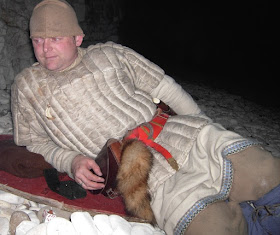 |
| Roman Subarmalis |
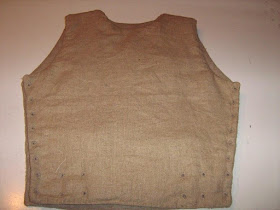 |
| Roman Subarmalis |
The purpose of a gambeson is to either be a primary or
secondary source of Kinetic trauma protection and this is achieved in various
ways,
Layers upon layers of Cloth usually linen although other
materials are documented as being used up to 30 layers in some cases, but the
average was 15 alternating layers (laid with weaves opposing)
This creates quite a resistance fabric, that has shown to be
pierce resistant and is quite similar to modern body armour. While it does
absorb some kinetic impact trauma these kinds of gambesons were mostly used alone
as a “jack”, sometimes used with a breastplate with no back-plate, or in gaps
as pieces of additional protection or reinforcement. The most detailed account
of a 30 layer Gambeson are found in the household accounts of Sir John Howard 1st
Duke of Norfolk in 1485 describing 30 alternating layers of Linen and fustian
(a linen and cotton mix) with an outer layer of Deerskin, often these were
quilted with the “channels” following the movement of the body, or by dictates
of fashion.
Sir John Howards household accounts also provides insight
into The "doublet of fence" for each front quarter 18 folds of white
fustian, 4 folds of linen, and one fold of black fustian for covering (23 folds
total). Each back quarter was made with 16 folds of fustian, 4 folds of linen,
and one fold of black fustian for covering (21 folds total). The sleeves were
of 6 folds of fustian, two of linen cloth and one of black fustian. Sir John
Howard paid 20d for the doublet. Interestingly, Robert Reed notes that there
are no records of arming doublets in Sir John Howard's books. But do mention
"Scottish" or "Welsh" jacks could these be referring to
arming doublets?
The other type of gambeson was a stuffed garment with 2 – 6
outer layers of Linen or deerskin with channels sewn into the fabric then
stuffed with a variety of materials, Raw wool made the most superior padding
but other materials were used like Tow (tow is the waste from linen cloth
production) and emphasised that the English considered that the softer they
were the better they were able to withstand blows. Other references mention the
illegal use of rotten linen ... the advantage of rotten linen is that it is
softer and moves better but is weaker and degrades quickly or even Horsehair
(Arabian)
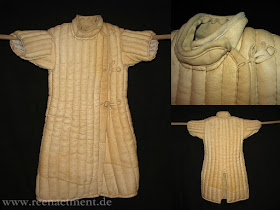 |
| Horsehair gambeson |
There are also many “treatments” to improve the protection
by Soaking the cloth in brine or vinegar to close the weave increasing resilience
or lice/odour control (as has been suggested by others) to linseed oil and
beeswax to increase longevity and water resistance (although this is not an
experiment I have yet tried) , but this treatment was used by sailors in period
to increase the speed of their ships at the cost of increasing the degradation
of the fabric.
Quilted gambesons with a batting as the absorption layer are
anachronistic and I have found no period references to their use, but quilting
with stuffed pockets were prevalent and even today a few samples have survived
in the form of bed coverings, One such example is the Tristan quilt that
depicts scenes from the story of Tristan and Isolde. This is one of three
surviving examples that were made in Sicily at the end of the fourteenth
century. These quilts were made of linen and only stuffed in selected areas
after the decorative stitching was completed.
The images from the Maciejowski Bible (circa 1250) Show
Aketons, but these terms were interchangeable in surviving documentation, but
the weight of evidence suggests that the “Aketon” referred to garments worn
under mail while the “gambeson” were worn overlaying mail, the Gambeson is often
referred to in period accounts as being worn by the common soldiery and is a
required piece of equipment required by the Assize of Arms of 1181, A proclamation of King Henry II of England
concerning the obligation of all freemen of England to possess and bear arms in
the service of king and realm and to swear allegiance to the king, on pain of
"vengeance, not merely on their lands or chattels, but on their limbs"
specifically Item 3: all burgesses and the whole community of freemen shall
have each a gambeson, an iron cap, and a lance (by lance its suggested that it
means pike/long spear not a horse lance)
 |
| Maciejowski Bible |
 |
| Maciejowski Bible |
Infantry as laid down in the Assize of Arms of 1182, often
wore one of two types of gambeson. One type was a sleeveless garment with a
stiff collar and stiffened arm openings; the other was a plain quilted garment
reaching the knee, with full-length sleeves.” Some had 4 padded collars, some
dags, some integral mittens and they were seen quilted in a variety of ways. Their styling often followed the fashion of the day, especially in the later
middle ages but the type of gambeson during those times remained as either the
padded or layer cloth design based on the availability of cloth and the type of
armour that was worn with it. (In the case of the poorest soldiers no
additional armour at all)
Examples from the fourteenth century include the pour point
of Charles de Blois (d. 1364) and the late fourteenth century jupon of Charles
VI. Fifteenth century.
 |
| Pourpoint of Charles de Blois |
 |
| Jupon of Charles VI |
These garments were worn under maille, over maille, under plate,
over plate, or on their own. Some were designed to encase maille or plate (coat
of plates/jack of plates some surviving examples had integrated padding so can
be referenced under the term “gambeson”)
The English Great Wardrobe Accounts detail the use of linen,
cotton wool (2.3 lbs/ 1.4 kg’s), silk thread, and linen thread for the construction
of an Aketon (13434) to be covered with fustian and enclosing a coat of mail or
plate.
When wearing a gambeson you are essentially wearing a quilt
which can have major drawbacks this was alleviated in many ways throughout the
ages, Even as detailed by the 15th Century Treatise “How a man
schall be armyd at his ese when he schal fighte on foote” (c.1450) an excerpt: He
shall have no shirt upon him but a doublet of fustian (cotton/linen weave) lined
with satin, cut full of holes, presumably to reduce heat build-up.
Quilted leather open jackets and trousers were worn by
Scythian horsemen before the 4th century BC, According to Herodotus (the father
of history), Scythian costume consisted of padded and quilted leather trousers
tucked into boots, and can be seen on Scythian gold ornaments crafted by Greek
goldsmiths.
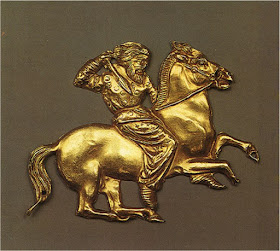 |
| Sythian Goldwork |
 |
| Sythian Goldwork |
Gambesons underwent a revolution from their first proven use
in the late 11th and early 12th centuries as an item of armour that simply
facilitated the wearing of mail to an item of independent armour popular
amongst infantry.
This quilted defense was also used as a standalone defense
by the lower ranking soldiers from the 12th century until at least the end of
the 15th century. It had tight-fitting sleeves which could end in straight or
dagged edges. The bottom of the aketon could also be straight or dagged. Almost
invariably, these defenses had collars that seem rather stiff. It appears that
the length of the aketon evolved with the armour worn above it. In the 12th and
13th centuries the hauberk was the main metal defense worn, and it reached to the
knees; the aketon of the period followed suit. During the 14th century the
hauberk shortened to reach above the knees and the aketon shortened
respectively. In the second part of the 14th century the waist of the aketon
narrowed significantly to reflect the other changes in fashion (the so-called
"wasp-waist"). These defenses could have had slits on the sides and
the back to allow for riding. Until the 14th century virtually all examples of
padded defenses worn under the armour were shown to be pulled over the head
like a shirt. This suggests that initially the quilted armour did not have an
opening on the front. During the 14th century, padded garments which open on
the front were shown. These were closed by lacing, or more rarely, buttons.
With the advance of full plate armour after 1410, the metal
plates used could withstand blows due to their rigidity and transfer the force
over a much wider body area. Thus the use of plate largely removed the
necessity for very thickly padded textile defences, but still required a
thinner garment to be worn. These new, thinner quilted garments are called
arming doublets (or arming coats, jacks or pourpoints). They were usually
shorter than the previously described aketons and gambesons, and had full
length sleeves. Arming doublets provide an armour attachment base in addition
to providing comfort in wear. Since plate covered most, but not all, of the
body (like some joints), the arming doublet was sometimes covered with mail
voids to add more protection to vulnerable spots like the armpits or groin.
 |
| 14th C Arming Doublet |
Out of period - Although quilted armour survived into the
English Civil War (1642–1651) in England as a poor man's cuirass, and as an
item to be worn beneath the few remaining suits of full plate, it was
increasingly replaced by the 'buff coat' – a leather jacket of rough suede.
While the use of linen has been shown in archaeological
evidence, the use of cotton – and cotton-based canvas – is disputed since the
access to large amounts of cotton cloth was not widely available at this time.
It is quite probable that Egypt (and Asia-Minor generally) still produced
cotton well after the 7th and 8th centuries and knowledge (and samples) of this
cloth was brought to Europe by the returning Crusaders. However logistics and
expense of equipping a town militia or army with large amounts of cotton-based
garments is doubtful, when flax-based textiles (linen) was in widespread use.
Padding was not just limited to the chest but also other
area’s Gamboised cuisses were quilted defenses for the thighs. Their method of
construction appears to have been much like that of aketons and gambesons. One
of the richest resources depicting what gamboised cuisses were like is the
Maciejowski Bible. According to depictions therein, gamboised cuisses were
"like a pair of vertically quilted waders cut immediately below the
knee" as described by Blair. These cuisses were sometimes adorned with
embroidery. Gamboised cuisses were in use from no later than 1250 until at
least the beginning of the 15th century, and maybe later. The basic
construction did not change much except when the cuisses were studded with
rivets. This was indicative of reinforcement with metal plates. Gamboised
cuisses were worn not only under the mail cuisses, but also over them. The lower
ends of the cuisses were secured just under the knee by a strap and buckle or
by a thong. One of the main roles of the cuisses was to serve as an attachment
base for the poleyns (a metal cup covering and protecting the knee).
 |
| Maile Voiders |
 |
| Leather stripes, not just for decoration but reinforcement. |
The head of the medieval soldier was often protected by
quilted, soft armour: the arming cap.
Arming caps were used until the 16th century, though past
the end of the 14th century they are rarely seen as a standalone form of head
protection. The arming cap was a padded version of the civilian
"coif" that closely fit the head and had ear lappets that were tied
together under the chin. Such arming caps were worn alone, or with some sort of
metal armour, mail coif or a helmet. There are examples of arming caps worn
over the mail coif suggesting that there might have been a thinner garment
underneath the mail coif to prevent chafing. Some arming caps have a thick
circlet around their periphery that is presumably used to support a helm.
Arming caps were often used in conjunction with the padded liners of helmets,
It is also arguable that indeed the arming caps may have evolved into the
padded linings of the helmets of 14th and later centuries.
The padded linings of two visored bascinets from the
Churburg castle were made from canvas or wool and stuffed with cow hair to
provide padding. Two mid-16th and mid-17th century quilted liners of German and
Italian close helmets reveal that they were made from linen and were stuffed
with cotton. The thickness of those liners varied from 2mm to 15mm, the
thinnest parts being where the stitching was.

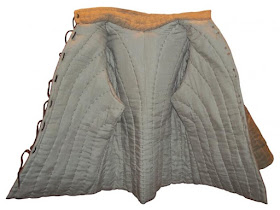
No comments:
Post a Comment